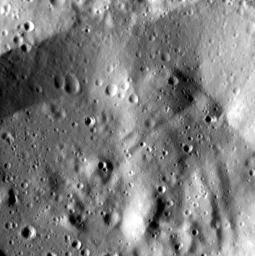Tears Roll Down
Caption:
This targeted image is a highly detailed view of the wall and floor of an unnamed crater to the north of
To Ngoc Van
. In the upper-left portion of the image, several small teardrop-shaped craters are present. The elongated shape results from formation on the sloping face of the larger crater's wall. The image is not
map projected
This image was acquired as a high-resolution targeted observation. Targeted observations are images of a small area on Mercury's surface at resolutions much higher than the 200-meter/pixel morphology base map. It is not possible to cover all of Mercury's surface at this high resolution, but typically several areas of high scientific interest are imaged in this mode each week.
Date acquired:
March 11, 2014
Image Mission Elapsed Time (MET):
36827656
Image ID:
5912113
Instrument:
Narrow Angle Camera (NAC) of the Mercury Dual Imaging System (MDIS)
Center Latitude:
57.0°
Center Longitude:
247.6° E
Resolution:
6 meters/pixel
Scale:
The scene is about 7 km (4 mi.) across
Incidence Angle:
70.5°
Emission Angle:
7.4°
Phase Angle:
77.9°
North is toward the lower right of the image.
Background Info:
The MESSENGER spacecraft is the first ever to orbit the planet Mercury, and the spacecraft's
seven scientific instruments and radio science investigation
are unraveling the history and evolution of the Solar System's innermost planet. MESSENGER acquired over 150,000 images and extensive other data sets. MESSENGER is capable of continuing orbital operations until early 2015.
For information regarding the use of images, see the MESSENGER
image use policy
.
Cataloging Keywords:
| Name |
Value |
Additional Values |
| Target |
Mercury |
|
| System |
|
|
| Target Type |
Planet |
|
| Mission |
MESSENGER |
|
| Instrument Host |
MESSENGER |
|
| Host Type |
Orbiter |
|
| Instrument |
Mercury Dual Imaging System (MDIS) |
|
| Detector |
Narrow Angle Camera (NAC) |
|
| Extra Keywords |
Crater, Grayscale, Map, Radio |
| Acquisition Date |
|
| Release Date |
2014-05-19 |
| Date in Caption |
2014-03-11 |
|
| Image Credit |
NASA/Johns Hopkins University Applied Physics Laboratory/Carnegie Institution of Washington |
| Source |
photojournal.jpl.nasa.gov/catalog/PIA18440 |
| Identifier |
PIA18440 |

 Planetary Data System
Planetary Data System
